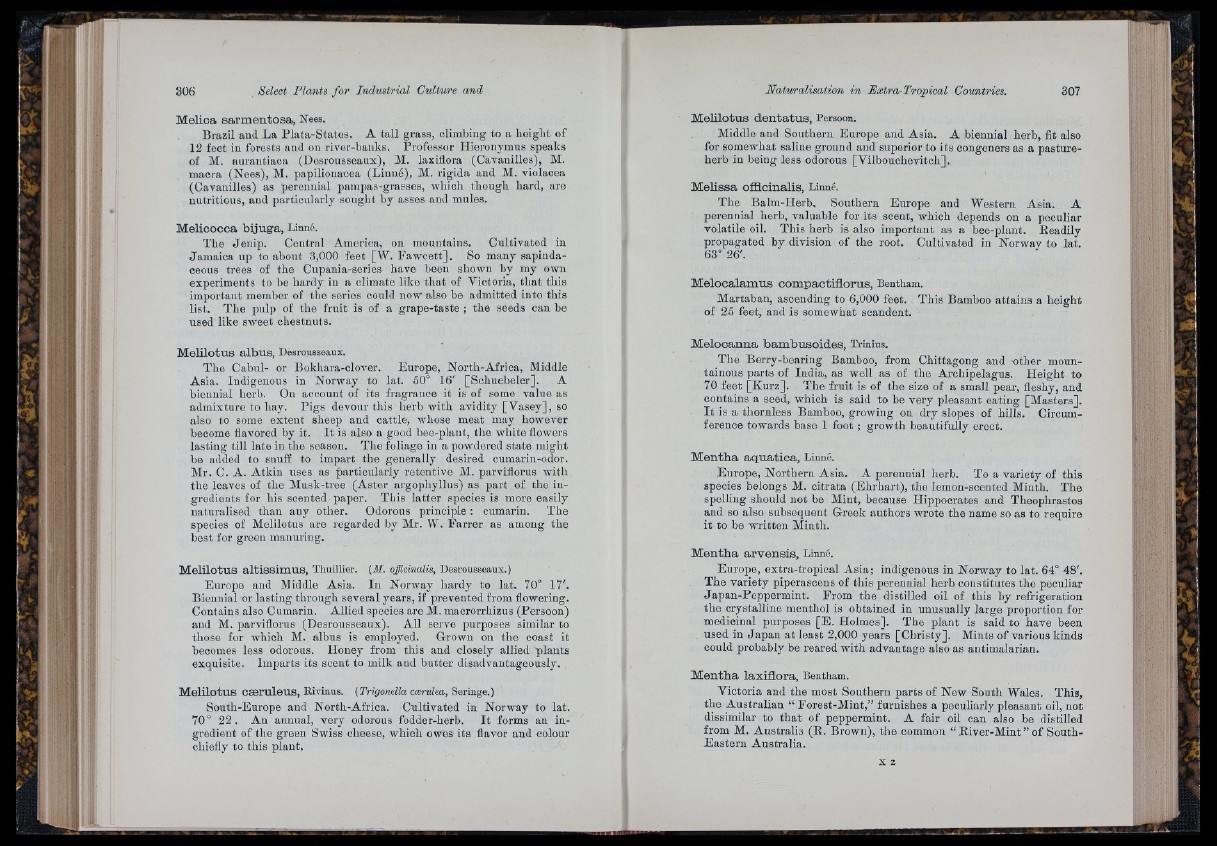
M e lic a s a rm e n to s a , Nees.
Brazil and La Plata-States. A tall grass, climbing to a height of
12 feet iu forests and on river-banks. Professor Hieronymus speaks
of M. aurantiaca (Desrousseaux), M. laxiflora (Cavanilles), M.
macra (Nees), M. papilioiiaeea (Linné), M. rigida and M. violacea
(Cavanilles) as perennial pampas-grasses, which though hard, are
nutritious, and particularly sought by asses and mules.
M e lico c c a b iju g a , Linné.
The Jeuip. Central America, on mountains. Cultivated in
Jamaica up to about 3,000 feet [W. Faw c e tt]. So many sapinda-
ceous trees of the Cupania-series have been shown by my own
experiments to be hardy in a climate like that of Victoria, th a t this
important member of the series could now also be admitted into this
list. The pulp of the fruit is of a grape-taste ; the seeds can be
used like sweet chestnuts.
M e lilo tu s a lb u s , Desrousseaux.
The Cabul- or Boklmra-olover. Europe, North-Africa, Middle
Asia. Indigenous in Norway to lat. 50° 16' [Schuebeler]. A
biennial herb. On account of its fragrance it is of some value as
admixture to hay. Pigs devour this herb with avidity [Vasey], so
also to some extent sheep and cattle, wliose meat may however
become flavored by it. I t is also a good bee-plant, the white flowers
lasting till late in the season. 'The foliage in a powdered state might
be added to snuff to impart the generally desired cumarin-odor.
Mr. C. A. Atkin uses as particularly retentive M. parviflorus with
the leaves of the Musk-tree (Aster argophyllus) as part of the ingredients
for his scented paper. 'Tliis latter species is more easily
naturalised than any other. Odorous principle : cumarin. The
species of Melilotus are regarded by Mr. W. Farrer as among the
best for green manuring.
M e lilo tu s a ltis s im u s , 'Lhuillier. (M. officinalis, Desrousseaux.)
Europe aud Middle Asia. In Norway hardy to lat. 70° 17'.
Biennial or lasting through several years, if prevented from flowering.
Contains also Cumarin. Allied species are M. macrorrhizus (Persoon)
and M. parviflorus (Desrousseaux). All serve purposes similar to
those for which M. albus is employed. Grown on the coast it
becomes less odorous. Honey from this and closely allied plants
exquisite. Imparts its scent to milk aud butter disadvantageously.
M e lilo tu s oæ ru le u s , Rivinus. {THgonella coertdea, Seringe.)
South-Europe and North-Afriea. Cultivated iu Norway to lat.
70 ° 22 . An annual, very odorous fodder-herb. I t forms an ingredient
of the green Swiss cheese, which owes its flavor and colour
chiefly to this plant.
M e lilo tu s d e n ta tu s , Persoon.
Middle and Southern Europe and Asia. A biennial herb, fit also
for somewhat saline ground and superior to its congeners as a pasture-
herb in being less odorous [Vilbouchevitch].
M e lis s a offlcinalis, Linné.
The Balm-Herb, Southern Europe aud Western Asia. A
perennial herb, valuable for its scent, which depends on a peculiar
volatile oil. This herb is also important as a bee-plant. Readily
propagated by division of the root. Cultivated in Norway to lat.
63° 26'.
M e lo c a lam u s c om p a c tiflo ru s , Bentham.
Martaban, ascending to 6,000 feet. This Bamboo attains a height
of 25 feet, and is somewhat scandent.
M e lo c a n n a b am b u so id e s , Trinins.
The Berry-bearing Bamboo, from Chittagong and other mountainous
parts of India, as well as of the Archipelagus. Height to
70 feot [Kurz]. 'The fruit is of the size of a small pear, fleshy, and
contains a seed, which is said to be very pleasant eating [Masters].
I t is a thornless Bamboo, growing on dry slopes of hills. Circumference
towards base 1 foot ; growth beautifully erect.
M e n th a a q u a tic a , Linnc.
Europe, Northern Asia. A perennial herb. To a variety of this
species belongs M. citrata (Ehrhart), the lemon-scented Minth. The
spelling should not be Mint, because Hippocrates aud Theophrastos
and so also subsequent Greek authors wrote the name so as to require
it to be written Minth.
M e n th a a rv e n s is , Linné.
Europe, extra-tropical Asia; indigenous in Norway to lat. 64° 48'.
'The variety piperascens of this perennial herb constitutes the peculiar
Japan-Peppermint. From the distilled oil of this by refrigeration
tbe crystalline menthol is obtained in unusually large proportion for
medicinal purposes [E . Holmes]. The plant is said to have been
, used in Japan a t least 2,000 years [Christy]. Mints of various kinds
could probably be reared with advantage also as antimalarian.
M e n th a la x iflo ra , Bentham.
Victoria aud the most Southern parts of New South Wales. This,
the Australian “ Forest-Mint,” furnishes a peculiarly pleasant oil, not
dissimilar to th a t of peppermint. A fair oil can also be distilled
from M. Australis (R. Brown), the common “ River-Mint ” o f South-
Eastern Australia.